Prussian Blue Cathode Materials for Aqueous Sodium-ion Batteries: Preparation and Electrochemical Performance
Author:LI Yong. Prussian Blue Cathode Materials for Aqueous Sodium-ion Batteries: Preparation and Electrochemical Performance. Journal of Inorganic Materials[J], 2019, 34(4): 365-372 doi:10.15541/jim20180272
TOB New Energy can provide a full set of battery material and battery equipment for Lithium-ion battery and sodium-ion battery, etc.
Prussian blue (PB) is a kind of metal-organic framework complex that displays wide application prospect as cathode material for aqueous sodium-ion batteries. In this study, PB composites were prepared by a single source method. Furthermore, effects of reaction temperature, time and concentration of hydrochloric acid on PB morphology and electrochemical performance were systematically investigated. The results showed that crystallinity and electrochemical stability of PB were improved by increasing reaction temperature. The aqueous sodium-ion battery with PB synthesized at 80℃as cathode material displayed a capacity retention of 93.9% after 100 cycles. The particle size of PB grew with the extension of reaction time until 6 h. It’s exhibited that the extended reaction time was beneficial to the cycle performance of device fabricated with PB prepared for 10 h, delivering 90% capacity retention after 100 cycles. Increment of the hydrochloric concentration acid changed the surface morphology, and thus improved electrochemical performance of PB. When the concentration of hydrochloric acid reached 0.20 mol/L, a capacity of 67.5 mAh/g could be maintainted after 100 discharge-charge. This work may provide theoretical and experimental gaidence for preparing high performance PB-based aqueous sodium-ion batteries.
The synthesis methods of Prussian blue include electrochemical deposition method, hydrothermal method, template synthesis method, co-precipitation method and single source method. Among them, the single source method only needs a single precursor, the experimental operation is simple, the experimental process is easy to control, and the uniformity of the generated Prussian blue particles is good. Therefore, the single-source method was used to prepare Prussian blue, and the effects of reaction temperature, reaction time, and hydrochloric acid concentration on the microscopic structure and electrochemical performance of Prussian blue were mainly explored.
Preparation of Prussian Blue
Prussian blue was prepared by a single source method, and in situ composite with Klein blue. Heat deionized water to 80 °C, and quickly prepare 100 mL of a 20 mmol/L Na4Fe(CN)6 solution with this hot water solvent. Then 48 mg of KB was added, and ultrasonic vibration was used for 15 min to make KB uniformly dispersed in the Na4Fe(CN)6 solution. Add 14.5g of NaCl and 0.088g of VC reducing agent to the solution, put the above solution into a water bath, add a certain amount of HCl after the temperature rises to the reaction temperature, and continue to stir until the reaction ends to obtain a precipitate. Wash 3~5 times with deionized water in the centrifuge, the speed is set to 10000 R /min, the time of each wash is 3 minutes, until the pH value of the supernatant after centrifugation is 7, and then put it into the vacuum oven at 80℃to dry for 24 hours, finally get the target product.
(1) The reaction time was controlled to be 4 hours and the concentration of hydrochloric acid was kept constant at 0.10 mol/L, and the effect of temperature was explored by changing the reaction temperature (50, 60, 65, 70 or 80℃). The samples were labeled as PB-50°C, PB-60°C, PB-65°C, PB-70°C and PB-80°C.
(2) The reaction temperature was controlled at 65℃and the concentration of hydrochloric acid was kept at 0.10 mol/L, and the effect of the reaction time was explored by changing the reaction time (4, 6, 8, 10 h). The samples were labeled PB-4h, PB-6h, PB-8h and PB-10h.
(3) The reaction temperature was controlled at 65 °C and the reaction time was kept constant at 4 hours, and the influence of the concentration of hydrochloric acid was explored by changing the concentration of hydrochloric acid (0.05, 0.10, 0.15, 0.20 mol/L). The samples were labeled PB-0.05M, PB-0.10M, PB-0.15M and PB-0.20M.
Battery Preparation
Batteries were prepared using the samples prepared above as active materials. First take 10 mg of PVDF binder, add an appropriate amount of NMP solvent to make a 3wt% colloid. A further 90 mg of the well ground active material was added and stirred uniformly to make a slurry. The prepared slurry was uniformly coated on titanium foil, and then placed in a 60 °C oven for 2 h drying. Then vacuum-dried in a vacuum drying oven at 90 °C for 10 hours, taken out and weighed for use. A 1 mol/L Na2SO4 solution was used as the electrolyte. The Prussian blue electrode material (Prussian blue loading: 2 mg∙cm-2) was used as the working electrode and the counter electrode, and the saturated calomel electrode was used as the reference electrode to form a complete aqueous battery test system. The cells obtained with PB-50℃, PB-60℃, PB-65℃, PB-70℃and PB-80℃as electrode materials were labeled as BPB-50℃, BPB-60℃, BPB-65℃, BPB-70℃and BPB-80℃. Similarly, the cells obtained by using PB-4H, PB-6H, PB-8H, PB-10H, PB-0.05m, PB-0.10m, PB-0.15m and PB-0.20m as electrode materials were labeled as BPB-4H, BPB-6h, BPB-8H, BPB-10H, BPB-0.05m, BPB-0.10m, BPB-0.15m, BPB-0.20m.
Conclusion:
(1) Mechanism of Synthesis of Prussian Blue by Single Source Method
When the precursor Na4Fe(CN)6 is in an acidic atmosphere, part of Fe2+ in Fe(CN)64- will be separated out and may be oxidized to Fe3+. Both Fe3+ and Fe2+ can combine with undecomposed Fe(CN)64- to form PB precipitates (Fig. 1). Therefore, factors such as temperature, time and concentration of hydrochloric acid will affect the microscopic morphology and crystal structure of PB, and then change the electrochemical performance of PB.
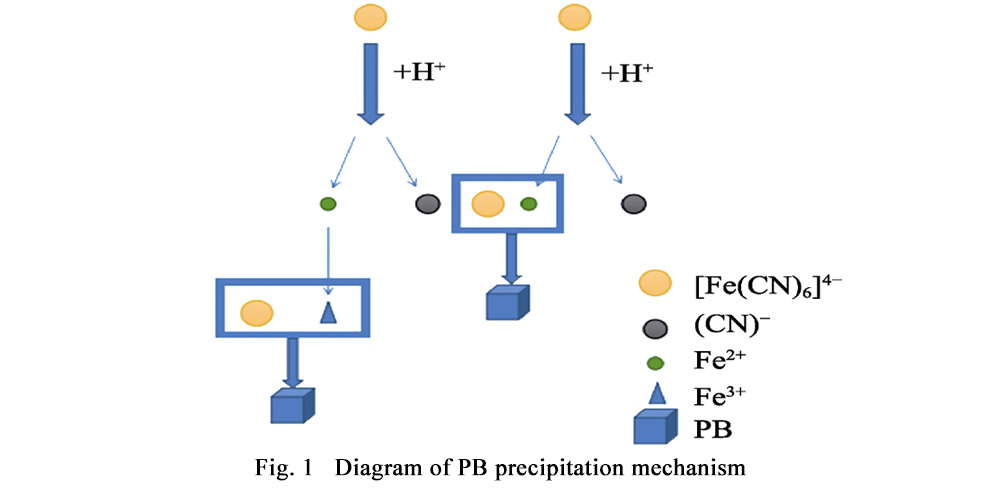
(2) Influence of reaction temperature
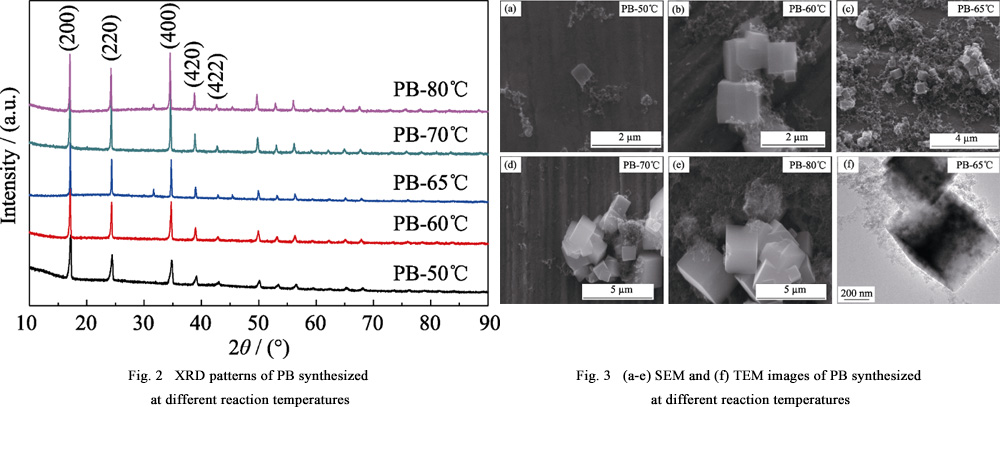
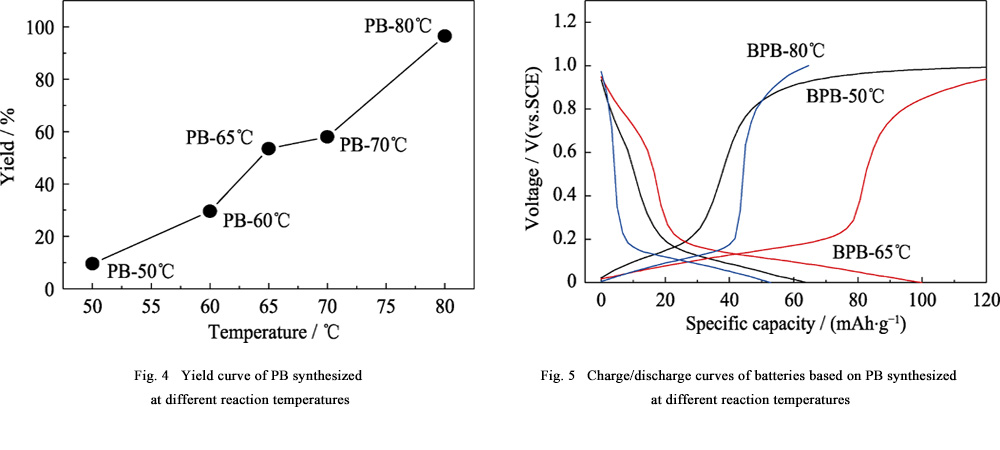
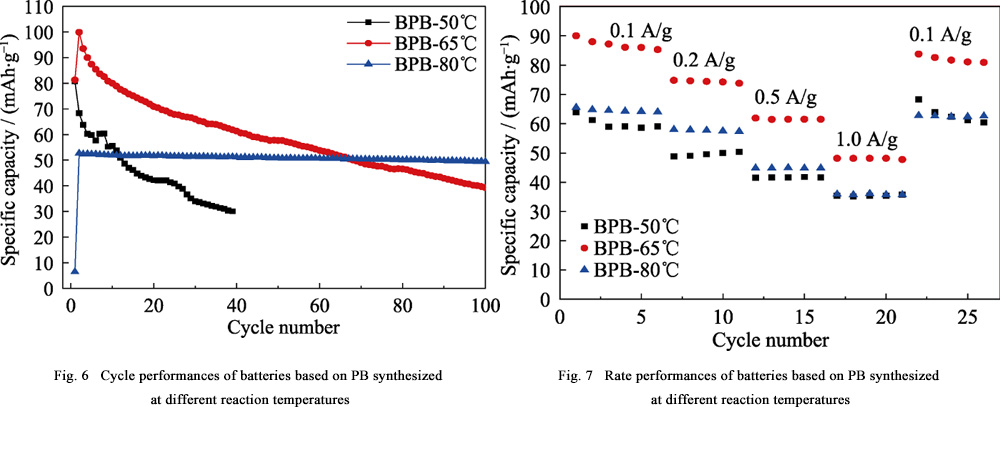
(3) The effect of reaction time
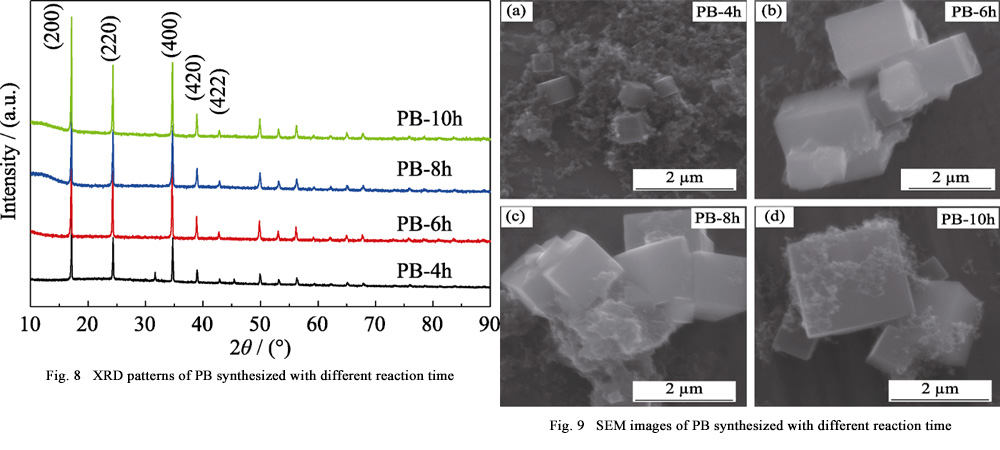
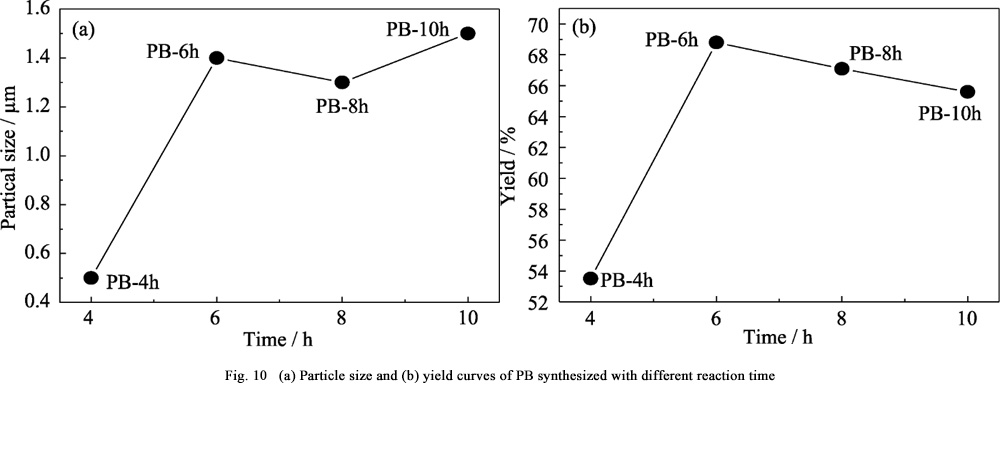
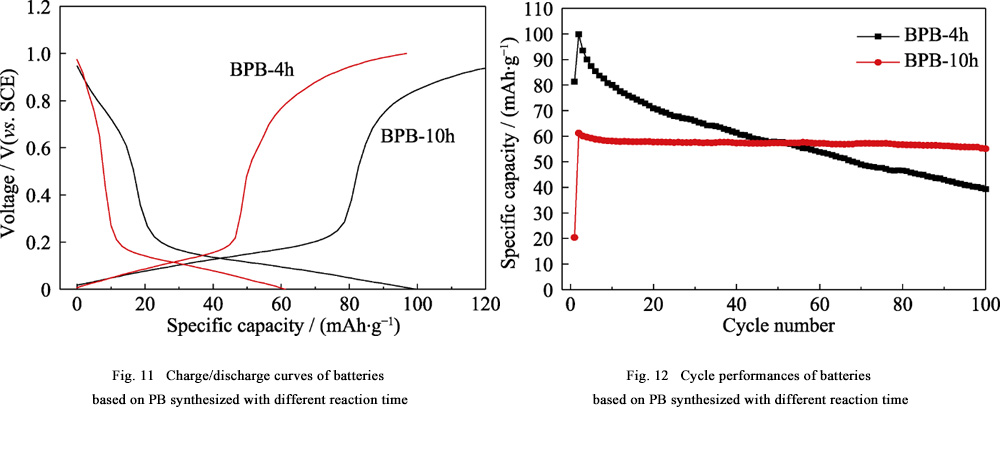
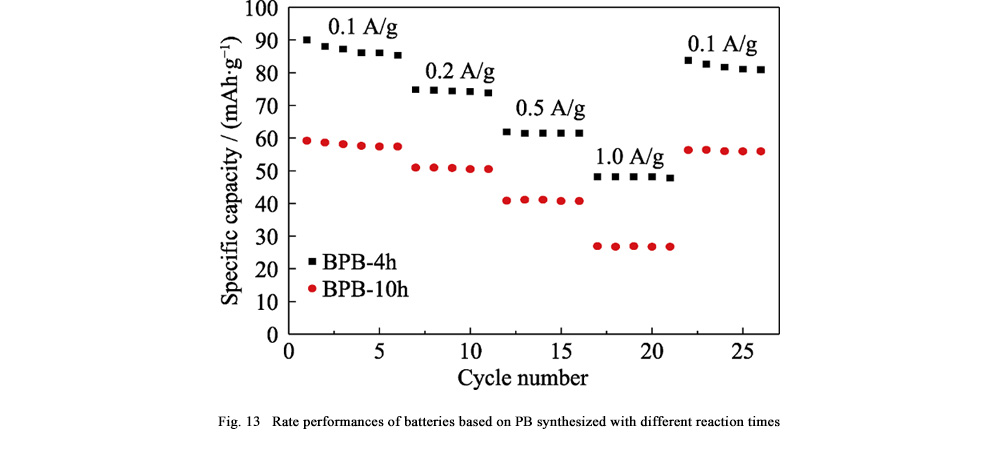
(4) The effect of hydrochloric acid concentration
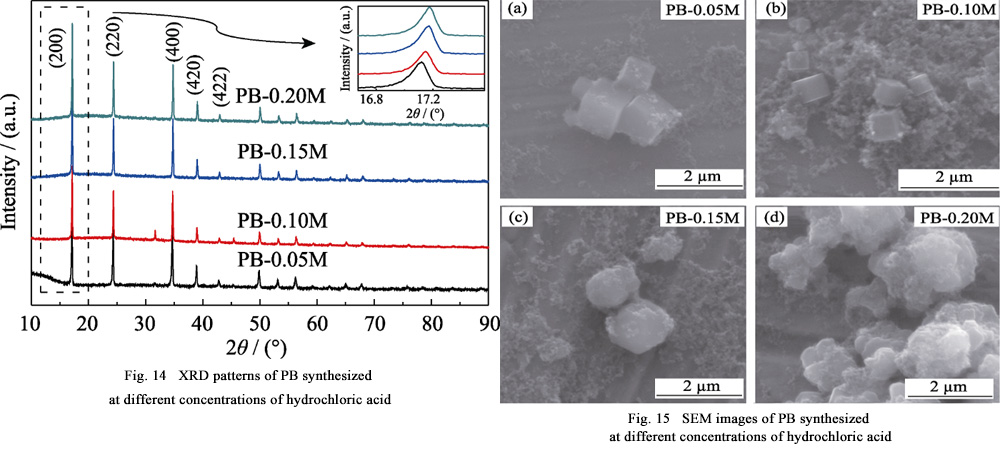
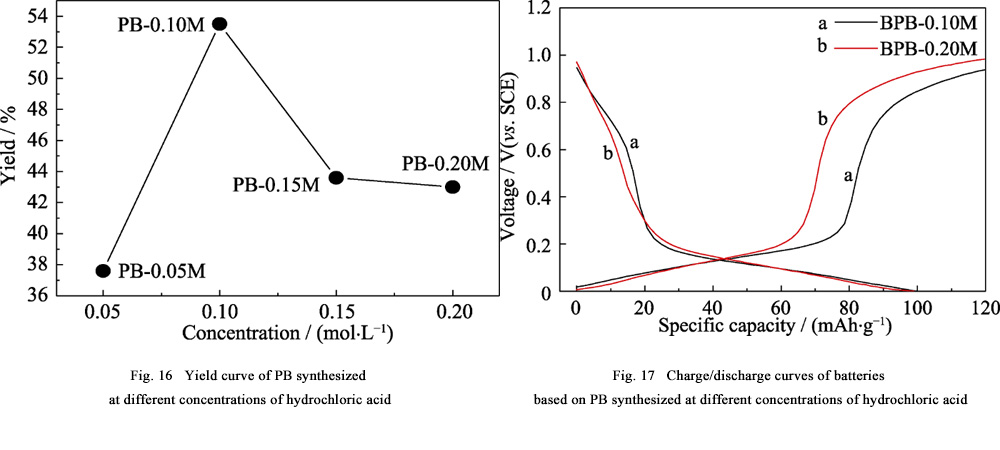
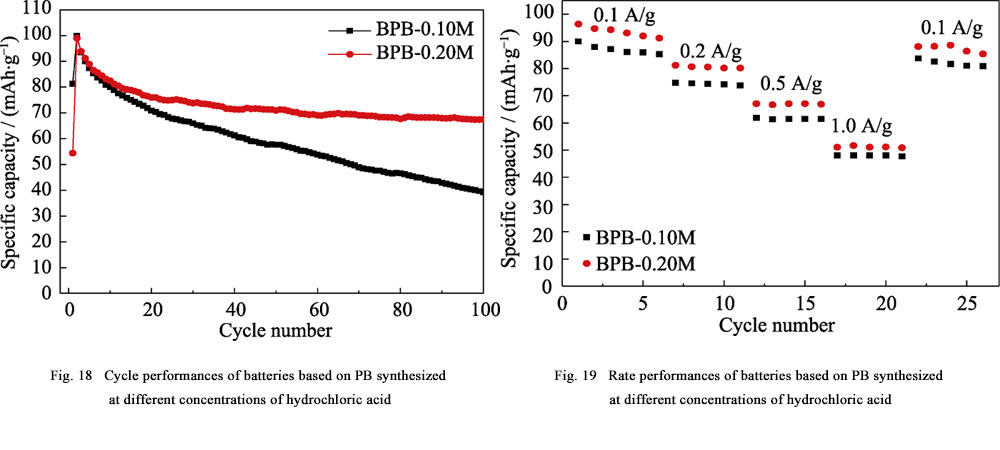
Prussian blue has been widely used in the field of aqueous sodium ion battery energy storage. It is of great significance to study the synthesis rule and electrochemical performance of Prussian blue. In this paper, Prussian blue composites were prepared by single source method. The effects of reaction temperature, reaction time and concentration of hydrochloric acid on the morphology, structure and electrochemical properties of Prussian blue composites were systematically studied.
According to research findings:
(1) The reaction temperature has an effect on the crystallinity, stacking and yield of PB. Under the condition of 50-80 °C, with the increase of temperature, the crystallinity of the formed PB grains is getting better and better, while the stacking phenomenon becomes more and more. The more serious it is, the yield also increases, and the yield of PB synthesized at 80℃reaches 96.5%. The electrochemical performance test shows that the battery assembled with PB synthesized at 80℃as the cathode material has excellent cycle performance, and the capacity retention rate reaches 93.9% after 100 charge-discharge cycles. However, the battery assembled with PB synthesized at 65℃has better rate performance, and its specific discharge capacity is 48.1 mAh/g at a charge-discharge current density of 1.0 A/g.
(2) The reaction time has an effect on the particle size of Prussian blue crystals. The particle size of Prussian blue synthesized in 4 hours is about 500 nm, and the particle size increases to 1-2 µm with the prolongation of reaction time. However, after more than 6 hours, the grains did not grow further due to the decrease of the surface energy. The battery assembled with Prussian blue synthesized for 10 hours showed good cycle performance, and the capacity retention rate reached 90% after 100 charge-discharge cycles.
(3) The concentration of hydrochloric acid will change the morphology and lattice constant of Prussian blue. When the concentration of hydrochloric acid is 0.05 and 0.10 mol/L, it does not affect the morphology of Prussian blue, but only affects the yield. When the concentration is 0.10 mol/L, the yield is higher. However, the concentration of 0.15 and 0.20 mol/L will change the morphology of Prussian blue, and the concentration of 0.20 mol/L can significantly improve the cycling stability and rate performance of batteries using Prussian blue as the cathode material.